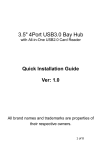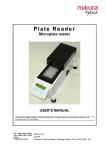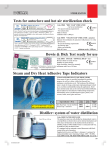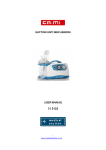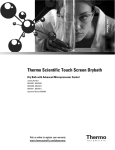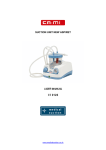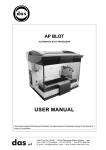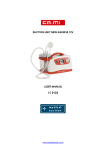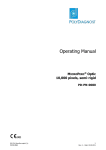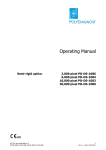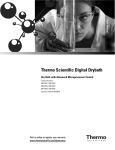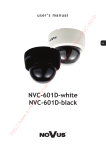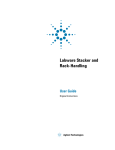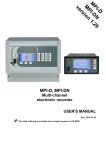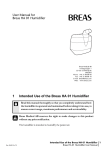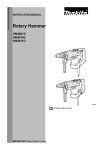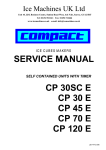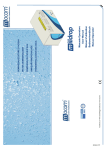Download dassrl - pro
Transcript
Plate Washer USER MANUAL This manual contains DAS reserved information. All rights reserved. Unauthorized copying of this manual or part of it is prohibited. das srl Viale Tivoli Km 18,642 – 00018 Palombara Sabina (Roma) - Italy Tel. (+39) 0774 66840 – 0774 637070 - Fax 0774 634039 E-mail: [email protected] - http://www.dasitaly.com PLATE WASHER USER MANUAL Causal Date Emissione Rev.00 04.02.2002 Rev. 01 19.07.02 Rev. 02 27.05.2004 Doc. N° M05-EN Rev.02 Date 27.05.2004 Revision description New edition issue Da A1 a A2 New CE Declaration Page 3 PLATE WASHER USER MANUAL Doc. N° M05-EN Rev.02 Date 27.05.2004 Page 4 CONTENTS INTRODUCTION ................................................................................................................................................... 5 0.1. DESCRIPTION ....................................................................................................................................... 5 0.2. WARRANTY ........................................................................................................................................... 5 0.3. CE CONFORMITY................................................................................................................................. 6 SECTION 1 - GENERAL SAFETY WARNINGS ............................................................................................... 7 1.1. DANGER-WARNING SYMBOLS ........................................................................................................ 7 1.2. INTENDED USE OF THE INSTRUMENT.......................................................................................... 7 1.3. USE OF THE INSTRUMENT................................................................................................................ 7 SECTION 2 - GENERAL INFORMATION ........................................................................................................ 8 2.1. INSTRUMENT DESCRIPTION: PURPOSE AND FEATURES....................................................... 8 2.3. INSTRUMENT DESCRIPTION............................................................................................................ 8 2.4. INSTRUMENT FUNCTIONING PRINCIPLE.................................................................................. 10 2.5. INSTRUMENT TECHNICAL DATA................................................................................................. 11 SECTION 3 - PACKAGING, TRANSPORT AND STORAGE ....................................................................... 12 3.1. GENERAL WARNINGS ...................................................................................................................... 12 3.2. PACKAGING ........................................................................................................................................ 12 3.3. INSTRUMENT TRANSPORTATION................................................................................................ 12 3.4. STORAGE OF THE INSTRUMENT.................................................................................................. 12 SECTION 4 - INSTALLATION AND START-UP INSTRUCTIONS ............................................................ 13 4.1 PLACING THE INSTRUMENT ......................................................................................................... 13 4.2 POWER SUPPLY.................................................................................................................................. 13 SECTION 5 - HOW TO USE PLATE WASHER ............................................................................................. 14 5.1. INTRODUCTION ................................................................................................................................. 14 5.2. SWITCHING THE INSTRUMENT ON ............................................................................................. 14 5.4. NEW PROGRAM SET UP................................................................................................................... 17 5.5. PROGRAM MODIFICATION ............................................................................................................ 19 5.6. PROGRAM RUN .................................................................................................................................. 20 5.7. PRIME.................................................................................................................................................... 22 5.8. DISPLAYED MESSAGES ................................................................................................................... 22 SECTION 6 - PC CONNECTION ....................................................................................................................... 23 6.1. INTRODUCTION ................................................................................................................................. 23 6.2. CONNECTION PLATE WASHER – COMPUTER.......................................................................... 23 SECTION 7 - MAINTENANCE AND CONTROLS ......................................................................................... 24 7.1. PREVENTIVE MAINTENANCE AND CONTROLS....................................................................... 24 7.2. TROUBLESHOOTING (DIAGNOSIS) .............................................................................................. 25 7.3. REPAIRS................................................................................................................................................ 25 SECTION 8 - DISINFECTION AND PUT OUT OF SERVICE ...................................................................... 26 8.1. INSTRUMENT DISINFECTION ........................................................................................................ 26 8.2. PUT THE INSTRUMENT OUT OF SERVICE ................................................................................. 27 8.3. DEMOLISHING PROCEDURE.......................................................................................................... 27 PLATE WASHER USER MANUAL Doc. N° M05-EN Rev.02 Date 27.05.2004 Page 5 INTRODUCTION 0.1. DESCRIPTION This manual provides the operator with all the necessary instructions for a safety, suitable use as well as the instrument maintenance recommendations. Manual content: • introduction - warranty information, Service maintenance and the CE mark conformity declaration • section 1 - general safety-warnings; • section 2 - general information such as the producer data, technical data, instrument performances, etc.; • section 3 - packaging, transport and storage instructions; • section 4 - installation and start up; • section 5 - operating instructions; • section 6 - PC connection instructions; • section 7 - the user’s periodic maintenance and checking, the trouble shooting at user’s level and the repair policy; • section 8 - instrument disinfection, how to put it out of service and demolishing instructions; • section 9 - spare parts list, consumable material and accessories. This manual is considered as a part of the instrument; it has to be at the operator’s hand as well as at the maintenance operator’s availability. For accurate installation, use and maintenance, please read the following instructions carefully. In order to avoid damages to the instrument or to people, carefully read the “GENERAL SAFETY WARNINGS” Section 1, describing the suitable operating procedures. In case of breakdowns or any troubles with the instrument, apply to the local Technical Service. 0.2. WARRANTY Each provided instrument is completely tested, and guaranteed for twelve months from delivery. The warranty affects all the mechanical and electrical parts. It is granted only for a proper installation, use and maintenance in compliance with the given instructions in this manual contained. According to this warranty, DAS commits itself to repairing or replacing all the parts which show off to be defective from the beginning. The warranty does not include any responsibility for direct or indirect personal and material damages, caused by improper use and maintenance of the instrument. All parts that are subject to deterioration, because of their specific use, are excluded from the warranty. Due to a misuse of the instrument the above mentioned warranty does not include (if requested) the travel and labor-hour expenses as well as all the accommodation expenses. 0.2.1. Asking for Service DAS is always at the Customer’s disposal for any kind of information about use, maintenance, installation, etc.. When asking for service please refer to this manual pointing out the data reported on the identification label (registration number and production year). Only qualified Technicians are entitled to fix the instrument; ordinary maintenance should be carried out by the user, as described in this manual. DAS Technical Service or a licensed Service Center with Specialized Technicians, with suitable instrumentation and original spare parts are always available for extraordinary maintenance (repair), under a yearly assistance contract or on specific demand. 0.2.2. Ordering the spare parts Parts subject to deterioration or defective which need to be replaced have to be requested as shown below. Ordering the spare parts, the following data are to be mentioned: • customer’s purchase order • name and version of the instrument • instrument code number • part code number • description of the part • requested quantity • name and company address to deliver the ordered goods. Replacing the parts, the use of ORIGINAL SPARE PARTS guarantees the efficiency and a lasting instrument life. PLATE WASHER USER MANUAL 0.3. Doc. N° M05-EN Rev.02 Date 27.05.2004 Page 6 CE CONFORMITY Declaration of conformity according to the 98/79/EC In-Vitro Diagnostic medical devices Directive (IVDD) DAS s.r.l., manufacturer of “Plate Washer”, Automated microplate washer, class of risk In-Vitro Diagnostic Medical Devices, declares that the mentioned system complies with the European Directive 98/79/EC (IVDD). The present conformity declaration is based upon the following requirements: Quality Management System (ISO 9001:2000): Working Procedures and Instructions for • Design process control; • Manufacturing process control; • Tests and Checks. System documentation: • Technical documents; • Risk analysis; • User manual; • Service manual. The Managing Director The instrument conforms to the following EC Directives, including the last modifications: − 98/79/EC regarding in-vitro diagnostic medical devices − 73/23/EC regarding low voltage − 89/336/EC regarding Electromagnetic Compatibility The below harmonized standard specifications have been applied: Quality system: − EN ISO 9001:2000 “Quality management systems” Risk analysis: − EN 14971 (2000) “Application of risk management to medical devices” Safety: − EN 61010 -1 (1997) “Electrical equipment safety requirements for measurement, control and laboratory use Part 1: General requirements” Electromagnetic Compatibility: − EN 61326 -1 (1998) “Electrical equipment for measurement, control and laboratory use – EMC requirements Part 1: General requirements” PLATE WASHER USER MANUAL Doc. N° M05-EN Rev.02 Date 27.05.2004 Page 7 SECTION 1 - GENERAL SAFETY WARNINGS 1.1. DANGER-WARNING SYMBOLS In this manual the following symbols are to remind the user of the safety rules: This is a symbol of generic DANGER. It means that serious dangers might occur to the operator if the described precautions are not fulfilled. This is a symbol of high electrical voltage; by touching parts reporting this label, life endanger might occur. Parts reporting this label can be handled only by qualified operators after having unplugged the instrument. This symbol indicates that the instrument makes use of chemical reagents and other dangerous (corrosive, irritant and harmful) CHEMICAL SUBSTANCES which can cause damages to people and things. When this label is found, pay attention to the producer’s recommendations This symbol indicates that the instrument involves the handling of samples which can be infected (urine and human serum). In this condition INFECTIONS or CONTAMINATION might occur. Pay attention to the general safety warnings when in presence of such biological substances. Use protective clothes, gloves and glasses. This symbol indicates that damages to the instrument and/or its incorrect results could occur if the given warnings are not respected This symbol is to advise that the instrument or part of the manual which is particularly important has to be consulted. 1.2. INTENDED USE OF THE INSTRUMENT The instrument is designed to be used in the following working conditions: • washing of micro-titer plate • work at room temperature and humidity, according to the specified data; • do not power the instrument in a potentially explosive environment or at risk of fire. The instrument has to be used as described in this manual. Any other use has to be regarded as improper. 1.3. USE OF THE INSTRUMENT The instrument has to be used for the expected purposes and in perfect technical conditions, by qualified personnel, in working conditions and maintenance operations as described in this manual, according to the safety rules. This manual contains instructions for qualified operators. • Qualified User has to make sure that environmental condition is suitable, the installation is correct, the use and maintenance are proper, according to the general safety rules as well as to the particular precautions described in the manual (although he is not entitled to repair the instrument). • Qualified Technician is entitled to maintain and fix the instrument, according to the instructions received and using the original spare parts. Alterations of the instrument are prohibited. The user is liable for any instrument improper modification as well as the deriving consequences. Should the machine need extraordinary maintenance, ask for DAS Service or for licensed service centers. The maintenance will be carried out by Specialized Technicians that will be able to fix the instrument using the original spare parts to replace the defective ones. PLATE WASHER USER MANUAL Doc. N° M05-EN Rev.02 Date 27.05.2004 Page 8 SECTION 2 - GENERAL INFORMATION 2.1. INSTRUMENT DESCRIPTION: PURPOSE AND FEATURES PLATE WASHER is a microplate automated washer. It can be programmed according to a specific protocol. In a combination with a microplate reader can be useful to automatize the ELISA washing process. The free program open system allows the operator to run any possible plate washing by setting up the wanted program through its in-built keyboard. 2.3. INSTRUMENT DESCRIPTION Components of different views of the below pictured instrument: Front view − two lines by 16 characters display, − alphanumerical key-pad, − Micro titer plate carriage Rear view: − power socket and switch, − RS232 output connector − identification label. Display Keypad Micro titer plate carriage Front view RS232 connector Power socket and switch Identification label PLATE WASHER USER MANUAL Page 9 Doc. N° M05-EN Rev.02 Date 27.05.2004 2.3.1. Display and keypad • • • • Press F1 or F2 keys to select one of the two functions displayed on the screen low line Press SET key to modify some of the set parameters (e.g. date and hour). Press ESC key to go back to the preceding menu. Press ENTER key to enter the data when provided from the specific menu. NOTE: The keys SET and ENTER have different functions according to the specific menu as better specified in the SECTION 5 of this manual. PLATE WASHER Washer Prime F1 F2 1 2 3 4 ESC 5 6 7 8 SET 9 0 fig.2.4 2.3.2. Micro titer plate carriage The instrument is provided with a micro titer plate carriage to move the micro titer plate towards the inside washer. fig. 2.5 PLATE WASHER USER MANUAL 2.4. Doc. N° M05-EN Rev.02 Date 27.05.2004 INSTRUMENT FUNCTIONING PRINCIPLE Below (fig.2.6) is the diagram representing the main functional elements of the instrument. fig. 2.6 Page 10 PLATE WASHER USER MANUAL 2.5. Doc. N° M05-EN Rev.02 Date 27.05.2004 Page 11 INSTRUMENT TECHNICAL DATA Display Alphanumerical 2 lines 16 characters LCD Keypad 17 keys, two of which with variable functions to guide the user. Program setting up − washing volume − delay time before starting the washing cycle − washing cycle delay between strips − strip selection to start with washing − number of strips to be washed − number of washing cycles for each strip − number of the plate washing cycles − Final aspiration for the single strip − Plate washing aspiration starting Program memorization storing capability of 100 programs RS232 serial output 9600 baud, 1 start, 8 data, 1 stop, no parity, XON/XOFF protocol Electrical power requirement Standard 230 VAC 50 Hz Optional 115 VAC 60 Hz Power consumption 80 W max Operating conditions temperature from +10 to +35°C relative Humidity up to 85% Shelf condition temperature from -10 °C up to +60 °C relative humidity up to 85% Dimensions width 34 mm, height 18.5 mm, depth 36 mm Weight 13 Kg INSTRUMENT EQUIPMENT: • • • • • • User’s manual Three 1 liter bottles for Wash and Waste and Cleaner. Tubing kit AC power Cable Fuses kit 1 Dust cover Additional accessories (optional): • PC cable connection PLATE WASHER USER MANUAL Doc. N° M05-EN Rev.02 Date 27.05.2004 Page 12 SECTION 3 - PACKAGING, TRANSPORT AND STORAGE 3.1. GENERAL WARNINGS Before starting with the packaging operations the machine has to be put out of service, as well as before the transportation and storage the instructions as indicated in Section 8 of this manual have to be properly observed The instrument has been used with samples potentially infected (urine, human sera etc.) that could have been caused INFECTED CONTAMINATIONS. General safety warnings about biological substances potentially infected have to be observed. Before putting the instrument out of service, IT HAS TO BE DISINFECTED! Before transportation or storage of the instrument, draw up the minutes of declaration of disinfection dated and signed by a qualified person. 3.2. PACKAGING Packaging is needed anytime the instrument has to be transported or shipped by courier or other means. To pack the instrument follow the instructions as below described: − put the instrument into the original packaging box or into a suitable cardboard box; in this case the instrument has to be properly protected by plastic protective material. − mark the package with address, instrument identification and warning labels: “OUT OF SERVICE MATERIAL” Biological substances potentially infected 3.3. INSTRUMENT TRANSPORTATION The transportation of the instrument when unpacked must be limited within the room where it is used, avoiding damaging bumping. When shipped or transported the instrument has to be provided with DISINFECTION DECLARATION CERTIFICATE (see Sec. 8 of this manual). 3.4. STORAGE OF THE INSTRUMENT Before storing the instrument for a long period, pack it carefully as described above. Relative humidity has to be less than 85% and temperature between 0°C and 50°C. The instrument disinfection declaration has to be labeled on the packaging before storing it. (see Sec. 8 of this manual) PLATE WASHER USER MANUAL Doc. N° M05-EN Rev.02 Date 27.05.2004 Page 13 SECTION 4 - INSTALLATION AND START-UP INSTRUCTIONS Installing and setting up the instrument, the safety warnings and general rules described in Section 1 must be observed. 4.1 PLACING THE INSTRUMENT The instrument has to be placed on a leveled bench. Room temperature has to be between 15 and 32 °C with a relative humidity below 80%; protect it from direct sunshine. 4.2 POWER SUPPLY Once the instrument has been placed, plug it to a power of 220VAC by the supplied cable. fig.4.1 Warning: make sure that the electrical power is the one as requested and indicated on the identification label of the instrument ! [ 230 V~ or 115 V~ ] Warning: make sure that the fuses correspond to the ones indicated on the identification label of the instrument and in the manual! 230 VAC mains # 2 quick fuses 1 A 115 VAC mains # 2 quick fuses 2 A Page 14 Doc. N° M05-EN Rev.02 Date 27.05.2004 PLATE WASHER USER MANUAL SECTION 5 - HOW TO USE PLATE WASHER 5.1. INTRODUCTION The flow diagram below indicates how the instrument is used. Detailed information for each step can be found in the indicated paragraph. Table 5.1 GENERAL FLOW DIAGRAM IN ITIA L MENU IN S TR U M E N T SE T UP PR IM E F UN C T ION PR O GR A M SE T LA N GU A G E DE L E T E M E M OR Y NE W P RO GR A M IN S TR U M E N T TE S T PR O G. M E M OR Y RU N PR O G R A M 5.2. SWITCHING THE INSTRUMENT ON The safety warning and general rules described in Section 1 have to be observed when using the instrument When switched on, the instrument automatically checks the functionality of its main parts; it show the heading containing the instrument name, the software revision, it checks the plate carriage home position. SELECT Washing Prime Then the initial menu is shown as in fig. 1 F1 Select one of the two options as shown on the display lower line (Washer or Prime) by pressing the function keys F1 or F2 F2 1 2 3 4 ESC 5 6 7 8 SET 9 0 fig. 5.1 Initial menu Page 15 Doc. N° M05-EN Rev.02 Date 27.05.2004 PLATE WASHER USER MANUAL When this initial menu is displayed the SET button assume specific functions: • SET button is to modify some parameters (as specified in the SET menu chapter); • When in this menu, ENTER button (usually it allows to enter data when required on the specific menu) is not enabled. • ESC usually allows to go back to the previous menu NOTE: SET and ENTER, in particular menus can change their function as after explained. By pressing SET button when in the initial menu (fig. 1), some instrument parameters can be modified. In the succeeding phases use ESCAPE to go back to the initial menu, use SET to go to the next menu. 5.3.1. Language selection From the initial menu, press SET button only once, the LANGUAGE SELECTION menu is displayed. After the selection, the DELETE MEM MENU is displayed. LINGUA / LANGUAGE Change F1 5.3.2. How to delete stored programs DELETE MEM menu allows programs. to delete filed F2 SET DELETE PROGRAMS A ll Num -----------------F1 F2 SET DELETE PROGRAMS All Num F1 F2 F2 F1 GO TO SET SHAKING TEST When F1 key is pressed, in order to avoid fortuitous mistakes, a further confirmation, before deleting all the filed programs, is required. If F1 is pressed, the identification number of the programs to be deleted is required, then press ENTER. Before deleting the selected program a confirmation is required. Then the menu DELETE PROGRAM is displayed again. DELETE PROGRAMS PROG no: [nn] ----------------------------F1 F2 ENTER Go back to DELETE PROGRAMS menu ARE YOU SURE yes no -------------------------F1 F2 F1/F2 Go back to PROGRAM DELETED menu PLATE WASHER USER MANUAL Page 16 Doc. N° M05-EN Rev.02 Date 27.05.2004 5.3.3. Set shaking SET SET SHAKING menu allows to set the shaking speed of the plate S E T S H A K IN G S et SET -----------------F1 F2 SET SHAKING F1 Set SPEED = n from 1 to 5 -------------------------F1 F2 GO TO INSTRUMENT TEST F1 F2 ENTER Executes a test 3 sec. long 5.3.4. Instrument test SET INSTRUMENT TEST RUN F1 INSTRUMENT TEST SET RUN -------------------------------F1 F2 F1 F2 Press F1 to enter the Service function. The instrument test has the following functions: Plate to move the plate Aspirator to move the aspirator up and down Pump1 to run pump1 Pump2 to run pump2 Valve to open/close valve Test on strip 1 to calibrated the dispenser go back to language SELECT MENU SERVICE PLATE WASHER USER MANUAL SET Page 17 DISPENSER CALIBRATION TEST ON STRIP 1 run factor -------------------------------F1 F2 F2 F1 VOLUME FACTOR (x.xxx) = ___ -------------------------------F1 F2 Liquid vol.(xxx) + -------------------------------F1 F2 Press F1 to start the strip dispensation test. Set the volume to be dispensed (from 200 to 400µl in step of 50µl) Press Enter The dispensation take place on strip 1 EN TER After the dispensation, a visual check has to be made on the plate, to verify if the dispensation is correct. (use a pipette to verify the effective dispensed volume). F1/F2 EN TER SET T HE LIQUID VOLUME Eventually repeat the dispensation test . If a correction is needed change the volume factor(F2). Press Enter and repeated the test up to a satisfactory result. DISPENSING LIQUID STRIP 1 -------------------------------F1 F2 F1 Doc. N° M05-EN Rev.02 Date 27.05.2004 REPEAT? yes no -------------------------------F1 F2 F2 5.4. NEW PROGRAM SET UP SELECT washing prime -------------------------------F1 F2 Select “washing” pressing F1 Select a new program set up (F2) Digit the starting strip position and press Enter. (if we set zero at this request it will always repeat before program execution and the number of the strip to wash will be set to zero) F1 SELECT PROGRAM memory new -------------------------------F1 F2 F2 Digit the number of strips to wash (or activate) and press Enter. (if we set zero at this request it will always repeat before program execution) Set the desired liquid volume from 200µl to 400µl (in step of 50µl) or 0 and press Enter. Starting strip position(nn)= -------------------------------F1 F2 ENTER Number of strip to wash (nn)= -------------------------------F1 F2 If the liquid volume is 0 the machine will perform only an aspiration of the plate. ENTER Liquid vol.(nnn) + -------------------------------F1 F2 Select a washing cycle or an activation cycle as needed pressing F1 or F2. Press Enter after the selection ENTER Liquid vol. >0 =0 Plate management [wash] activ. -------------------------------F1 F2 F1/F2 ENTER Sele ct wash or activa te Go to the plate strip empty Follows in the next page PLATE WASHER USER MANUAL Doc. N° M05-EN Rev.02 Date 27.05.2004 Page 18 PLATE ACTIVATION follows from previous page activate Plate management Time delay to asp.(nns)= -------------------------------F1 F2 ENTER Set the time after witch the application plate take place on all the plate. wash Stri p soak time (nns)= -------------------------------F1 F2 PLATE WASH Set the time ( sec.) of liquid permanence into the strip. Press Enter. F1 Stri p washing cycles (nn)= -------------------------------F1 F2 Set the number washing cycle for the strip. Press Enter ENTER Strip empty [yes] no -------------------------------F1 F2 Select (F2/F2) if the strip has to be left empty or full after the washing cycle. Press Enter. ENTER Strip washing delay (nns)= -------------------------------F1 F2 Set the time delay (sec.) between the washing cycle of one strip and the beginning of the washing cycle of the following strip. Press Enter. ENTER No. of washing cycles (nn)= -------------------------------F1 F2 Set the number of complete washing cycle for the plate. Press Enter. ENTER Set the time delay between a cycle and the next one. =1 Cycles Select plate empty or not at the end of the working cycle ( if the strips were full). >1 Waiting beetwen cycles (000s)= -------------------------------F1 F2 Set the incubation time before washing take place. Press Enter. ENTER no Strip empty Plate empty [yes] no -------------------------------F1 F2 yes ENTER Plate starting incub.(nnmin)= -------------------------------F1 F2 SHAKING yes [no] -------------------------------F1 F2 ENTER F1 NAME = XXXXXX incr decr -------------------------------F1 F2 GO TO THE FIRST EMPTY FREE POSITION F1 Go to Program RUN Shaking selection: if shaking is selected the plate will be shacked during incubation time (at the selected shaking speed, see par. 5.3.3) Insert the name of the program using F1/F2. Press Enter to go to program RUN ENTER SAVE PARAMETERS yes no -------------------------------F1 F2 Press F1 to save the parameters. F2 PLATE WASHER USER MANUAL 5.5. Doc. N° M05-EN Rev.02 Date 27.05.2004 Page 19 PROGRAM MODIFICATION SELECT washing prime -------------------------------F1 F2 F1 SELECT PROGRAM memory new -------------------------------F1 F2 F2 Select the program by number or by the list of existent programs. SELECT PROGRAM number list -------------------------------F1 F2 F1 F2 PROGRAM NO.: -------------------------------F1 F2 ENTER 001 NAME XXXXXX next previous -------------------------------F1 F2 SET 001 NAME XXXXXX show change -------------------------------F1 F2 F2 STARTING STRIP POSITION nn -------------------------------F1 F2 Follow NEW PROGRAM SETUP Pressing set is possible: − to show the parameter (F1) of the program. − To change the parameters of the program following the steps of par. 5.4 Doc. N° M05-EN Rev.02 Date 27.05.2004 PLATE WASHER USER MANUAL 5.6. PROGRAM RUN 5.6.1. GENERAL FLOW DIAGRAM - START- prog r. sto red ? yes yes mod if y prog r. ? no no progr. set up progr. mod ifi cation yes PRI ME ? RUN no Page 20 Doc. N° M05-EN Rev.02 Date 27.05.2004 PLATE WASHER USER MANUAL 5.6.2. PROGRAM START UP SELECT prime washing -------------------------------F1 F2 F1 SELECT PROGRAM memory new -------------------------------F1 F2 F1 SELECT PROGRAM number list -------------------------------F1 F2 F2 F1 PROGRAM NO.: -------------------------------F1 F2 ENTER nnn NAME xxxxxx next previous -------------------------------F1 F2 F1/F2 SELECT THE PROGRAM ENTER FIRST POSITION STRIP >0 =0 POSITION STRIP initial(nn) -------------------------------F1 F2 ESC ENTER NUMBER STRIP >0 =0 NUMBER OF STRIP TO WASH -------------------------------F1 F2 ESC ENTER INSERT PLATE run -------------------------------F1 F2 F1 PRIME yes no -------------------------------F1 F2 F1/F2 RUN ESC Page 21 PLATE WASHER USER MANUAL 5.7. Doc. N° M05-EN Rev.02 Date 27.05.2004 Page 22 PRIME From the main Menu it is possible to process a complete prime at each working starting of the machine (use washing solution). SELECT Washing Prime -------------------------------F1 F2 In order to wash the hydraulic circuit the prime command has to be used at the and of each session to perform the above change the wash solution with distilled water and then prime at least two times. F2 PRIME ON 5.8. DISPLAYED MESSAGES In case of failure the instrument is able to display the below messages. See Section 8 for the needed operations MEMORY ERROR This message means that some memorized data are missing. MISSING CALIBR. This message means that instrument is not operative as the dispensation volume is not defined. PLATE WASHER USER MANUAL Doc. N° M05-EN Rev.02 Date 27.05.2004 Page 23 SECTION 6 - PC CONNECTION 6.1. INTRODUCTION The instrument is equipped with an RS232 serial port for PC connection. A cable and software are optionally available to link the instrument to PC (IBM or compatible in order to print , transfer and record the acquired data. To use different communication programs, be sure that the following parameters are set: − 8 bit − 9600 baud rate − no parity − stop bit 6.2. CONNECTION PLATE WASHER – COMPUTER Use a cable to link the instrument to the RS232 serial port. Make sure of its compatibility as following: • A 9 pins connector is available at the rear of the instrument (see fig. 6.1). • Two serial ports are located on the PC: usually a 9 pins or a 25 pins male connector. fig. 6.1 RS232 serial port location PLATE WASHER USER MANUAL Page 24 Doc. N° M05-EN Rev.02 Date 27.05.2004 SECTION 7 - MAINTENANCE AND CONTROLS ! 7.1. Only qualified personnel is entitled to carry out maintenance (see Section 1 of this manual). Carrying out the maintenance operations, follow the general warnings as described in Section 1 of this manual as well as the below safety rules PREVENTIVE MAINTENANCE AND CONTROLS Operation Period Cleaning Daily and/or at the end of each working session. General inspection and checks At interval of 6 months As the instrument could be used in different conditions and terms, maintenance has to be done according to the use of the instrument, the period indicated on the above table has to be taken on account as an average. After a long period of the instrument inactivity, a general maintenance is required before using it again. 7.1.1. Cleaning This symbol indicates that the instrument makes use of chemical reagents and other dangerous (corrosive, irritant and harmful) CHEMICAL SUBSTANCES which can cause damages to people and things. When this label is found, pay attention to the producer’s recommendations. This symbol indicates that the instrument involves the handling of samples which can be infected (urine and human serum). In this condition INFECTIONS or CONTAMINATION might occur. Pay attention to the general safety warnings when in presence of such biological substances. Use protective clothes, gloves and glasses. After each working session, clean the instrument carefully. − − − Use a water soaked cloth (or light detergent) to clean the instrument external parts To clean the micro titer plate location, use a water soaked cloth with 0.5% Sodium Hypoclorite. Make sure not to leave any loose threads. The room and desk where the instrument is placed have to be always clean; remove any dirt. Warning: cleaning the instrument, do not use alcohol or similar solutions! When cleaning don’t let electric parts (connectors, etc.) get wet. If necessary, before turning the instrument on, dry them out 7.1.2. Inspection and controls It is advisable to check periodically all the instrument parts. PLATE WASHER USER MANUAL 7.2. Doc. N° M05-EN Rev.02 Date 27.05.2004 Page 25 TROUBLESHOOTING (DIAGNOSIS) Some troubles that might occur during the instrument functioning as well as the specific remedy are shown in the following table. TROUBLE PROBABLE CAUSE The instrument doesn’t go The power source is faulty on REMEDY Check the power cord and source Check the fuses, if necessary replace them Incomprehensible messages are displayed The start has gone wrong Switch off the instrument and after while switch on again. In case of failure repetition call for Technical Assistance. MEMORY ERROR is displayed It means that some memorized Call for Technical Assistance data are missing. MISSING CALIBR. It means that the dispensation Calibrate the dispensation (see par. 5.3.3) volume is not defined. The instrument doesn’t dialogue with the PC Incorrect connection Check the cable connection, be sure of the serial port Check the program setting for the utilized serial port The instrument sends to the PC wrong messages 7.3. The instrument transmission is different from the one of the communication program Check the data transmission speed of the instrument and the one of the program are the same (9600 baud) REPAIRS Only simple repairs are allowed to the operator. In case of complex breakdowns, or defects might occur to the instrument, qualified technical interventions are required. REPAIR (extraordinary maintenance) has to be carried out (see Section 1) only by: • Authorized Technical Service licensed center, which can operate (on request or under assistance contract), by Specialized Technicians, using original spare parts. Transformations or modifications of the instrument are not allowed. The user is liable for any instrument improper use or modification and for the deriving consequences. PLATE WASHER USER MANUAL Doc. N° M05-EN Rev.02 Date 27.05.2004 Page 26 SECTION 8 - DISINFECTION AND PUT OUT OF SERVICE 8.1. INSTRUMENT DISINFECTION The instrument involves the handling of samples which can be infected (urine and human serum) and positive controls. In this condition INFECTIONS or CONTAMINATION might occur. Every part and accessory of the instrument must be considered potentially infected. Carefully disinfect the instrument, before transporting it to another place or before starting any maintenance. Before sending back the instrument it has to be carefully disinfected. Fill in a disinfection certificate and enclose it with the instrument. If the certificate is missing, the customs officers or your service center can refuse the instrument! 8.1.1. Disinfection Process Prior to any repair or maintenance intervention and before transporting the instrument a disinfection is necessary by using wide band solutions! Warning ! USE LABORATORY PROTECTIVE CLOTHES, DISPOSABLE GLOVES AND GLASSES WHILE DISINFECTING THE INSTRUMENT. Use one of the following wide band solutions: Aseptisol Manufacturer: Bode Chemie Amburg Germocid Plus Manufacturer: Germo S.p.a. Milano Lysetol Manufacturer: Schülke & Mayr Ges.m.b.H. If the above solutions are not available use other wide band disinfectant solutions. Use the solution only for the instrument surface. 1. Wear disposable gloves, protective glasses and suitable clothes. 2. Prepare an autoclave bag for the disposable items used for the disinfection and label the bag with an autoclave band mark. 3. Unplug the instrument in order to avoid explosions. 4. 5. Remove all the accessories and disinfect the ones which have to be sent with the instrument. Spray the disinfectant solution on the instrument surface. or use a cloth or paper soaked in a disinfectant solution. 6. Leave the solution on the instrument for 10 minutes and repeat the treatment from the preceding point. 7. Leave the solution on the instrument for 5 hours, clean the instrument surface by a light detergent or water to eliminate any dirt or disinfectant solution. 8 Carefully dry the instrument. 9. Put the instrument and its accessories into their original box. 10. Wash and disinfect the hands by using a light detergent. 11. Fill in a Disinfection Certificate and enclose it with the instrument. Doc. N° M05-EN Rev.02 Date 27.05.2004 PLATE WASHER USER MANUAL Page 27 8.1.2 Disinfection certificate The Disinfection certificate as shown below, has to be filled in and enclosed with the instrument before shipping it for a maintenance service. The certificate Has to be stuck on the instrument package. Disinfection certificate Instrument: Model: S.N.: We declare that : the instrument and its accessories never came in touch with dangerous biological substances, the instrument and its accessories have been disinfected and / or decontaminated to eliminate every biological substance. which could be dangerous for the staff. Responsible name: User Address: Country: Date 8.2. Signature PUT THE INSTRUMENT OUT OF SERVICE At the end of the instrument operating life, dispose of it taking in account the safety for people and environment. − Unplug the instrument and the PC. − If the instrument has been used, carefully disinfect and clean it following the above instructions or the internal rules of the laboratory. if the instrument has to be transported or stored, enclose the disinfection Certificate, dated and signed by a qualified operator. 8.2.1. Momentary stocking Disactivate the instrument and label it with warning signals of “OUT OF SERVICE ” (see Sec. 3). 8.3. DEMOLISHING PROCEDURE − − Dismantle the instrument parts that connect the elements according to their chemical nature Start demolishing procedure respecting the local current laws and regulations.



























